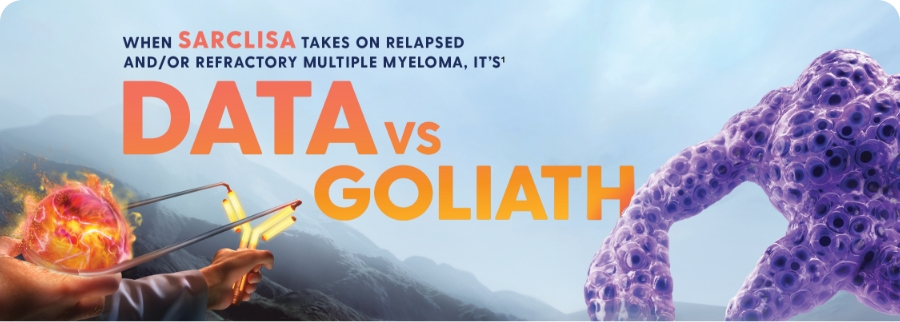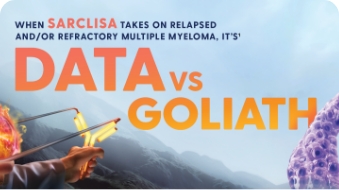

In post hoc and real-world analyses,
SARCLISA-based regimens demonstrated efficacy in patients across cytogenetic risk profiles and regardless of the line of prior therapies2,3
Unlock data that challenge your expectations of anti-CD38 efficacy:
SARCLISA + Kd
Uncover DeeperSubgroup Insights
SARCLISA + Pd
See subgroup &real-world data
Kd=carfilzomib and dexamethasone; Pd=pomalidomide and dexamethasone.
References: 1. SARCLISA [summary of product characteristics]. sanofi-aventis groupe: Paris, France; 2025. 2. Moreau P, Perrot A, Dimopoulos MA, et al. Isatuximab in relapsed multiple myeloma patients with ultra-high-risk cytogenetics: ICARIA-MM and IKEMA subgroup analysis. Poster presented at: European Hematology Association (EHA) 2023 Hybrid Congress; June 8-11, 2023; Frankfurt, Germany and online. 3. Decaux O, Fontan J, Perrot A, et al. Isatuximab plus pomalidomide and dexamethasone in patients with relapsed/refractory multiple myeloma in real‐world: the retrospective IMAGE study. Eur J Haematol. Published online May 7, 2025. doi:10.1111/ejh.14225
Subgroup Analysis of the IKEMA Trial:
SARCLISA + Kd demonstrated consistent efficacy in RRMM patients with various risk profiles




Adapted from Moreau et al. Presented at: European Hematology Association (EHA) 2023 Hybrid Congress; June 8-11, 2023; Frankfurt, Germany and online.
PFS hazard ratios were measured for different subgroups, including standard risk at 42.4 months (HR=0.496 [95% Cl: 0.294, 0.839]), extended high risk at 31.1 months (HR=0.531 [95% Cl: 0.310, 0.908]), and ultra-high risk at 17.1 months (HR=0.689 [95% Cl: 0.343, 1.385]).
At the time of data cutoff, the OS data were immature. Trial analysis is ongoing.
In the IKEMA trial, efficacy in these subgroups was consistent with the benefits seen in the ITT population (mPFS of 35.7 months vs 19.2 months; HR=0.58 [95% CI: 0.42, 0.79]).
For information on the IKEMA study design and main study outcomes, please visit sanofimyelomahcp.com
IKEMA Safety Profile
SARCLISA + Kd was well tolerated across all risk category subgroups in the phase 3 IKEMA trial. The incidence of Grade ≥3 TEAEs was generally higher in the SARCLISA + Kd arm than the control arm, regardless of risk profile, with the exception of standard-risk patients.
In the IKEMA dataset, for standard-risk patients, the most frequent Grade ≥3 TEAEs and haematologic abnormalities were neutropenia (15.4%), thrombocytopenia (21.5%), hypertension (24.6%), anaemia (16.9%), pneumonia (16.9%), and cardiac failure (1.5%), with no reported infusion-related reactions. Extended high-risk patients showed neutropenia (17.5%), thrombocytopenia (33.3%), anaemia (33.3%), pneumonia (17.5%), and hypertension (25.4%), with no infusion-related reactions but some cardiac failure (4.8%). Ultra-high-risk patients experienced neutropenia (40.0%), thrombocytopenia (32.0%), anaemia (28.0%), pneumonia (28.0%), hypertension (20.0%), and some infusion-related reactions (4.0%), with no cardiac failure reported.
IKEMA Risk Stratification
This retrospective examination of IKEMA data explored the impact of SARCLISA + Kd on PFS, OS,
and depth of response among patients with standard-risk, extended high-risk, and ultra-high-risk cytogenetics, which included those with 1q21+† multiple myeloma.
The risk profiles of patients in the IKEMA trial were determined using the following cytogenetic abnormalities: del(17p), t(4;14), t(14;16), and 1q21+.
- Standard risk was defined as the absence of these cytogenetic abnormalities
- Extended high risk was defined as the presence of 1 of these cytogenetic abnormalities
- Ultra-high risk was defined as the presence of ≥2 of these cytogenetic abnormalities
*The 95% confidence interval for standard risk, extended high risk, and ultra-high risk were (0.294, 0.839), (0.310, 0.908), and (0.343, 1.385), respectively.
†1q21+ included both gain(1q21) and amp(1q21).
CI=confidence interval; CR=complete response; HR=hazard ratio; ITT=intent to treat; Kd=carfilzomib and dexamethasone; mPFS=median progression-free survival; MRD-=minimal residual disease negative/negativity; ORR=overall response rate; OS=overall survival; PFS=progression-free survival; RRMM=relapsed and/or refractory multiple myeloma; TEAE=treatment-emergent adverse event; VGPR=very good partial response.
Reference: Moreau P, Perrot A, Dimopoulos MA, et al. Isatuximab in relapsed multiple myeloma patients with ultra-high-risk cytogenetics: ICARIA-MM and IKEMA subgroup analysis. Poster presented at: European Hematology Association (EHA) 2023 Hybrid Congress; June 8-11, 2023; Frankfurt, Germany and online.
Subgroup Analysis of the ICARIA-MM Trial:
SARCLISA + Pd showed efficacy regardless of cytogenetic risk in patients with RRMM1


Adapted from Moreau et al. Presented at: European Hematology Association (EHA) 2023 Hybrid Congress; June 8-11, 2023; Frankfurt, Germany and online.
PFS hazard ratios were measured for different subgroups, including standard risk at 19.1 months (HR=0.478 [95% Cl: 0.263, 0.866]), extended high risk at 8.5 months (HR=0.645 [95% Cl: 0.414, 1.006]), and ultra-high risk at 7.5 months (HR=0.437 [95% Cl: 0.188, 1.018]).1
OS rates were measured for standard-risk (HR=1.032 [95% CI: 0.542, 1.972]), extended high-risk (HR=0.842 [95% CI: 0.533, 1.330]), and ultra-high-risk subgroups (HR=0.796 [95% CI: 0.357, 1.776]).1
Key takeaway
SARCLISA delivered efficacy in standard-risk and extended high-risk patient groups, with ≥CR tripled in SARCLISA + Pd vs Pd alone.
In the ICARIA-MM trial, efficacy in these subgroups was consistent with the benefits seen in the ITT population (mPFS of 11.53 months vs 6.47 months; HR=0.596 [95% Cl: 0.44, 0.81]).1,2
For information on the ICARIA-MM study design and main study outcomes, please visit sanofimyelomahcp.com
ICARIA-MM Safety Profile
SARCLISA + Pd was well tolerated across all risk category subgroups in the phase 3 ICARIA-MM trial. The incidence of Grade ≥3 TEAEs was generally higher in the SARCLISA + Pd arm than the control arm, regardless of risk profile.
In the ICARIA-MM dataset, for standard-risk patients, the most frequent Grade ≥3 TEAEs and haematologic abnormalities were neutropenia (82.8%), thrombocytopenia (31.0%), anaemia (27.6%), and pneumonia (24.1%), with fewer cases of infusion-related reactions and hypertension (3.4% each), and no cardiac failure. Extended high-risk patients reported neutropenia (88.3%), thrombocytopenia (31.7%), anaemia (31.7%), and pneumonia (25.0%), with no infusion-related reactions or cardiac failure and lower rates of hypertension (1.7%). Ultra-high-risk patients showed neutropenia (81.8%), thrombocytopenia (54.5%), anaemia (36.4%), pneumonia (27.3%), and infusion-related reactions (9.1%), with no hypertension or cardiac failure.
ICARIA-MM Risk Stratification
This retrospective examination of ICARIA-MM data explored the impact of SARCLISA + Pd on PFS,
OS, and depth of response among patients with standard-risk, extended high-risk, and ultra-high-risk cytogenetics, which includes those with 1q21+† multiple myeloma.
The risk profiles of patients in the ICARIA-MM trial were determined using the following cytogenetic abnormalities: del(17p), t(4;14), t(14;16), and 1q21+.
- Standard risk was defined as the absence of these cytogenetic abnormalities
- Extended high risk was defined as the presence of 1 of these cytogenetic abnormalities
- Ultra-high risk was defined as the presence of ≥2 of these cytogenetic abnormalities
Real-World Evidence:
SARCLISA + Pd showed strong effectiveness regardless of line of prior therapies in patients with RRMM3
The IMAGE study,‡ a retrospective cohort analysis, evaluated the real-world effectiveness of SARCLISA + Pd in French EAP-treated patients.


Adapted from Decaux et al. Eur J Haematol. 2025. doi:10.1111/ejh.14225.
For the anti-CD38–naïve population (n=216), mPFS, ORR, and ≥VGPR were 16.6 months (95% CI: 13.2, NR), 50.0%, and 31.5%, respectively.3
Median OS was NR (95% CI: 18.9, NR) in the IMAGE study.3
IMAGE Study Safety Profile3
No new safety signals were observed in the IMAGE study compared with ICARIA-MM. However, the incidence of some AEs like infections was low, possibly due to the retrospective nature of the study.
In the safety population (n=299), 79 patients (26.4%) reported at least one adverse event. There were no new safety concerns identified, and no cases of viral re-infection were reported among the patients. One patient (0.3%) was noted to have developed a secondary primary malignancy. Only 4 patients (1.3%) permanently discontinued SARCLISA due to an AE, and there were no cases where SARCLISA was permanently discontinued due to neutropenia.
*The 95% confidence intervals for standard risk, extended high risk, and ultra-high risk were (0.263, 0.866), (0.414, 1.006), and (0.188, 1.018), respectively.1
†1q21+ includes both gain(1q21) and amp(1q21).1
‡IMAGE: a retrospective cohort study conducted in France among patients enrolled in EAPs for RRMM. It evaluated the safety and efficacy of SARCLISA + Pd in 294 patients. PFS, response rates, and coded adverse events were key endpoints.3
§The 95% confidence interval for the effectiveness population was (9.0, 15.0). For those receiving 1, 2, or ≥3 prior LOT it was (9.6, NR), (10.2, NR), and (4.4, 11.8), respectively. For lenalidomide-refractory patients it was (6.4, 12.4) and for those who are refractory at last prior LOT it was (14.8, NR).3
AE=adverse event; CI=confidence interval; CR=complete response; EAP=early access program; HR=hazard ratio; ITT=intent to treat; LOT=line of therapy; mPFS=median progression-free survival; NR=not reached; ORR=overall response rate; OS=overall survival; Pd=pomalidomide and dexamethasone; PFS=progression-free survival; RRMM=relapsed and/or refractory multiple myeloma; TEAE=treatment-emergent adverse event; VGPR=very good partial response.
References: 1. Moreau P, Perrot A, Dimopoulos MA, et al. lsatuximab in relapsed multiple myeloma patients with ultra-high-risk cytogenetics: ICARIA-MM and IKEMA subgroup analysis. Poster presented at: European Hematology Association (EHA) 2023 Hybrid Congress; June 8-11, 2023; Frankfurt, Germany and online. 2. SARCLISA [summary of product characteristics]. sanofi-aventis groupe: Paris, France; 2025. 3. Decaux O, Fontan J, Perrot A, et al. lsatuximab plus pomalidomide and dexamethasone in patients with relapsed/refractory multiple myeloma in real-world: the retrospective IMAGE study. Eur J Haematol. Published online May 7, 2025. doi:10.1111/ejh.14225

